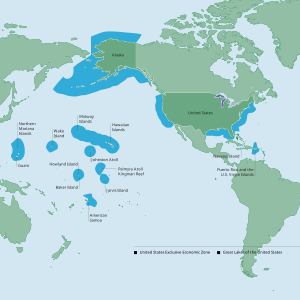Exclusive economic zone of the United States
The United States has the world's second-largest exclusive economic zone (EEZ). The total size is 11,351,000 km2 (4,383,000 sq mi)2.[1] Areas of its EEZ are located in three oceans, the Gulf of Mexico, and the Caribbean Sea. Most notable areas are Alaska, Hawaii, the East Coast, West Coast and Gulf Coast of the United States.
Geography
[edit]
The EEZ borders with Russia to the north west, Canada to the north, Cuba, Bahamas, Mexico to the south, Dominican Republic, British Virgin Islands, Anguilla to the south east and Samoa, Niue to the south west. The unincorporated territories of Guam, Puerto Rico, U.S. Virgin Islands and Northern Mariana Islands are included.
| Territory | EEZ area (km2) | EEZ area (sq mi) | Notes |
|---|---|---|---|
| 3,770,021 | 1,455,613 | A non-contiguous state in the northwest extremity of the North American continent. | |
| 1,579,538 | 609,863 | Including Midway Atoll, these islands form the Leeward Islands of the Hawaiian island chain. | |
| 915,763 | 353,578 | The mainland coastal states of the Eastern United States. | |
| 895,346 | 345,695 | These islands form the Windward Islands of the Hawaiian island chain. | |
| 825,549 | 318,746 | The mainland coastal states of the Western United States. | |
| 749,268 | 289,294 | An organized unincorporated Commonwealth of the United States. | |
| 707,832 | 273,295 | The mainland coastal states of the Southern United States. | |
| 442,635 | 170,902 | A National Wildlife Refuge in the U.S. Minor Outlying Islands. | |
| 434,921 | 167,924 | Including | |
| 407,241 | 157,237 | A National Wildlife Refuge in the U.S. Minor Outlying Islands. | |
| 404,391 | 156,136 | The only inhabited unorganized unincorporated territory of the United States. | |
| Palmyra Atoll and Kingman Reef | 352,300 | 136,000 | Both territories are National Wildlife Refuges in the U.S. Minor Outlying Islands. |
| 316,665 | 122,265 | A National Wildlife Refuge in the U.S. Minor Outlying Islands. | |
| 221,504 | 85,523 | An organized unincorporated territory of the United States. | |
| 177,685 | 68,605 | An organized unincorporated Commonwealth of the United States. | |
| 33,744 | 13,029 | An organized unincorporated territory of the United States. | |
| N/A[note 1] | N/A[note 1] | A National Wildlife Refuge in the U.S. Minor Outlying Islands. | |
| Total | 11,351,000 | 4,383,000 |
Disputes
[edit]Active
[edit]Canada
[edit]A wedge-shaped section of the Beaufort Sea is disputed between Canada and the United States, because the area reportedly contains substantial oil reserves.[6]
Dominican Republic
[edit]
Since 2007, the Caribbean country of the Dominican Republic in Hispaniola considers itself an archipelagic state, encroaching the long-established median or equidistance line equally dividing the EEZ of the Dominican Republic and Puerto Rico, and claiming portion of the EEZ claimed by the United States in relation to the archipelago of Puerto Rico, which is an American territory. The United States does not accept the archipelagic status and maritime boundaries claimed by the Dominican Republic.[7] Victor Prescott, an authority in the field of maritime boundaries, argues that, as the coasts of both states are short coastlines with few offshore islands, an equidistance line is appropriate.[8]
See also
[edit]- Magnuson–Stevens Fishery Conservation and Management Act
- Geography of the United States
- Exclusive economic zone of Canada
- Exclusive economic zone of Mexico
References
[edit]- ^ "UKNDA DISCUSSION PAPER" (PDF). Archived from the original (PDF) on 2020-11-25. Retrieved 2020-09-28.
- ^ Exclusive Economic Zones (EEZ) Archived 2 January 2014 at the Wayback Machine. Seaaroundus.org. Retrieved 23 July 2013.
- ^ EEZ area of Haiti
- ^ EEZ area of Jamaica
- ^ MARITIME CLAIMS – Navassa Island
- ^ "Transnational Issues CIA World Fact Book". Cia.gov. Retrieved 2012-01-10.
- ^ "Limits in the Seas No. 130 Dominican Republic: Archipelagic and other Maritime Claims and Boundaries" (PDF). United States Department of State Bureau of Oceans and International Environmental and Scientific Affairs. Retrieved 14 January 2014.
- ^ "ANALYSIS ON THE LEGITIMACY OF THE DECLARATION OF THE DOMINICAN REPUBLIC AS AN ARCHIPELAGIC STATE AND ITS LEGALITY UNDER THE UNITED NATIONS CONVENTION ON THE LAW OF THE SEA (UNCLOS) AND THE INTERNATIONAL LAW" (PDF). DIVISION FOR OCEAN AFFAIRS AND THE LAW OF THE SEA, OFFICE OF LEGAL AFFAIRS, THE UNITED NATIONS, NEW YORK, 2018. 15 December 2018. Retrieved 11 July 2024.
